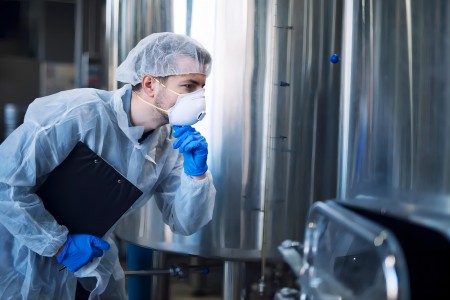PPE for Food Industry
Published on 2022/11/8

Share to:
PPE for Food Industry
This article discusses the importance of having personal protective equipment for food production workers and how you can implement proper PPE practices to maintain cleanliness safely and efficiently.
Food production is a messy business. From the moment a seed germinates and vegetation grows until it is harvested and ready to be consumed, food can leave various types of residue behind as it grows. From the outside, this might not look much, but every little bit counts when working in a food production environment. Littering of all sorts can have adverse effects on both plant health and worker safety. If you work in the food industry, then you know all too well how important maintaining cleanliness is. You also know that regular maintenance with PPE provides access to areas where cleaning or maintenance procedures cannot take place. Hence, why not integrate these two things? This article discusses the importance of having personal protective equipment for food production workers and how you can implement proper PPE practices to maintain cleanliness safely and efficiently.
The Importance of Personal Protective Equipment for Food Production Workers
As much as you might want to wear shorts every day because it is summer and you feel great about that, you need to understand how important it is to wear PPE when working in a food production environment. PPE for food production workers helps maintain cleanliness, prevents injuries and minimizes the risk of contamination of food. You might not realize it, but these practices keep your food production environment safe for all of your co-workers. In a food production environment, you are working with perishable food items, which are at high risk of contamination due to cross-contamination or improper storage and/or handling practices. When you use PPE, you have easier access to areas where cleaning or maintenance procedures cannot take place. When this is the case, then you don’t need to wear gloves and boots and you can still safely clean and maintain equipment. The reason this is so important is that you are preventing the spread of harmful microorganisms, such as bacteria and viruses, throughout your plant environment. PPE also improves employee morale, which can affect the productivity of your plant.
Steps to Implement PPE for Food Production Workers
To implement PPE for food production workers, it is important to first determine the type of PPE that will work best for your needs. It is important to understand that there are two types of PPE available for food production workers: personal protective equipment (PPE) and protective clothing. For workplace cleanliness, your first step should be to select PPE that will work best for the task at hand. Make sure that your PPE can be used for both clean and dirty tasks because having the right type of PPE will help you when it comes to maintaining cleanliness.
What are the Types Of PPE Available for the Food Industry?
There are many different types of PPE available for food production workers. These include: 1. Face protection - Face protection helps food production workers prevent inhalation of harmful substances while they are working with food. Many different types of face protection can be used in food production environments. Some of the more common types of face protection include: Full-face masks - Full-face masks are worn over the head and the mouth, covering most of the face. Because of the tight seal that is created when the mask is worn, harmful substances are prevented from entering the body through the mouth. Half-face masks - Half-face masks are designed to be worn over one-half of the face and one-half of the mouth. They are generally the second option for respirators when a full-face mask does not work correctly or does not provide the necessary protection. Respirators - Respirators are designed to provide an even tighter seal around the mouth and nose, blocking out harmful substances before they enter the body. Above-ground working levels (AWL) respirators are the most commonly used type of PPE for food production workers.
2. Neck protection - Neck protection helps food production workers protect their heads and neck while they are working with food. Many different types of neck protection can be used in food production environments.
How to Correctly Wear PPE for Food Production Workers
If you are at all unsure of how to correctly wear PPE for food production workers, then it is important to get training as soon as possible. You don’t want to experience any injuries because of incorrect PPE use. When selecting PPE for food production workers, you must consider the tasks that need to be performed, the risk of contamination that is present in your environment, and the requirements of your specific job. To ensure that you are wearing PPE correctly, it is important to make sure that the equipment is fitted properly and that it is being used correctly. If you are unsure of where to place the equipment or what type of PPE to use, then it is best to consult with your supervisor or other co-workers.
Conclusion
There are many benefits to implementing PPE for food production workers. By doing so, you will be able to maintain cleanliness and prevent injuries related to hazardous materials. It is important to note that PPE is not just for cleaning work areas, but can also be used when cleaning and maintaining equipment.


 WhatsApp
WhatsApp
Send us your message
You can send an email asking for the price and detailed information of this product. We will reply you as soon as we receive your email